Located in Siena, S.A.L.C.I.S. was founded in 1941 as a cooperative to unify pork butchers facing restrictions during WWII. Then, in the 1960s, one of the original members of S.A.L.C.I.S., Armando Morbidi, saw the possibility for a rebranded version of the coop into a family company “SALCIS” also began production of the traditional sheep’ milk Tuscan Pecorino.
Sheep have grazed the Sienese hillsides for centuries—and “mowed” the pastures of SALCIS for decades–but never in enough numbers for sufficient milk production to make cheese. This changed in the 1960’s when many Sardinian farmers and shepherds migrated to Tuscany to escape urban development, industrialization, and to protest military weapon testing on their island. The Tuscan landscape echoed the Sardinian countryside. The abundant Tuscan pastures were similar and familiar to them. Sheep’ milk was now plentiful in the region. Armando forged friendships with several shepherds, creating partnerships that blended Tuscan Pecorino-making methods and traditions with the ancient Sardinian recipes and cheesemaking ways. Armando–sole proprietor of SALCIS by then—began purchasing milk from local shepherds and collaborating with them on crafting Pecorino.
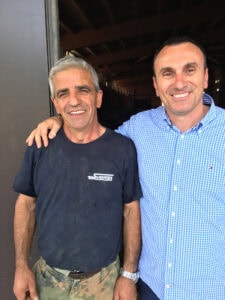
To this day, the relationship between the shepherds and the Morbidi family continues with Armando’s grandson and current president of SALCIS, Antonio Morbidi, and Sergio Zucca, son of a Sardinian shepherd. Antonio and Sergio have a relationship of esteem and mutual respect–and fun. The two are more like brothers, often laughing while they work hard. Sergio has been known to play with the sheep in a flurry of hay and happy sheep bleats.
For three decades, Sergio has been the shepherd to SALCIS ‘own herd of 1500 sheep which produce between 30% – 60% of the milk for their cheeses. The remainder of the milk needed for production is sourced from local shepherds.
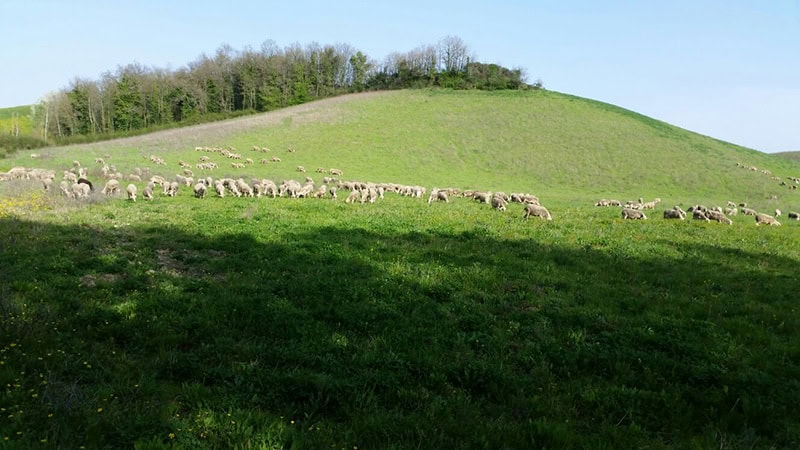
Whether from the SALCIS’ herd or surrounding herds, the premium quality milk is at the heart of SALCIS, and there are many natural contributors to the purity and flavor of the milk. Foremost are the pastures of the lush Sienese countryside untouched by chemical sprays with only natural fertilizers used. In addition, SALCIS practices crop rotation in the fields and pastures to ensure a balanced ecosystem and nutrient-rich soil structure.
“Pasture is the main resource for our sheep,” says Antonio. “Quality raw materials are a must for us. Thanks to our pastures, we can guarantee and check the process, from raw materials to finished product.”
Although most of the sheep’s diet is pasture, cereals such as oat, barley and wheat sourced from a local agricultural consortium are supplementally used.
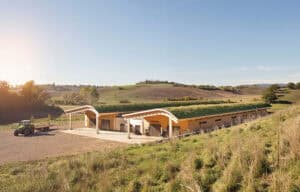
In 2007 SALCIS built its own sheepfold with the health and well-being of both the sheep and the land as its central purpose. The sheepfold is constructed of natural materials such as hay bale walls, wood, and a grass roof making a comfortable environment for the animals with a low impact on the land.
“To continue having the highest quality of milk, it’s necessary to keep the earth as it has been left from our fathers,” says Antonio.
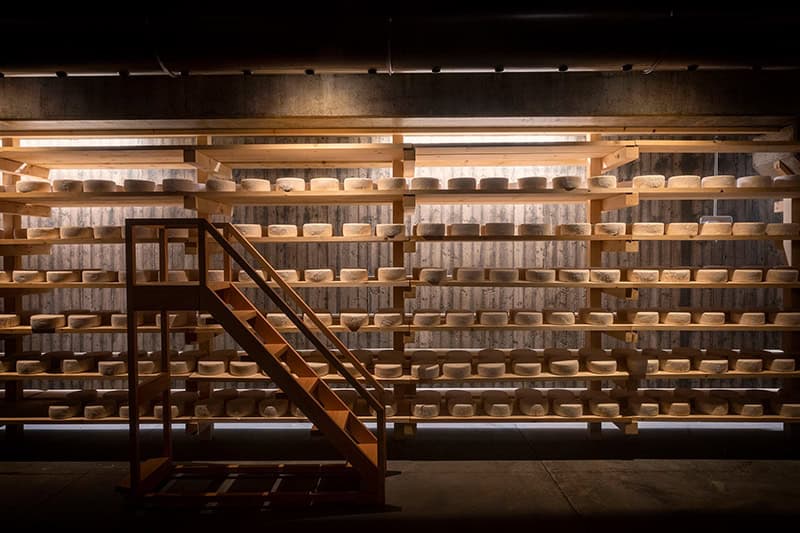
2020 marked the completion of a cellar with fir wood tables for aging cheeses. Although there is a ventilation system in the cellar, the natural consistency of the underground temperature and humidity creates ideal aging conditions that require little modern assistance.
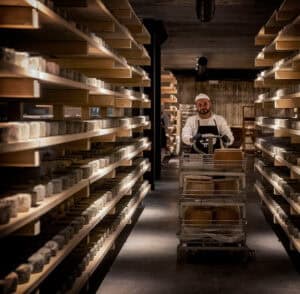
Domenico (aka “Mimmo”) is Aging Cave Manager and he oversees all cheese aging, flipping, humidity levels, cleaning, sanitizing etc. He has worked in Salcis for about 20 years.
SALCIS production of traditional Pecorino–and stewardship of the land which is the essence of their cheeses–continues with both Antonio and Sergio’s families.
“For some years [now] my grandchildren–who represent the fourth generation–have also begun to collaborate with the company,” Antonio says.
Sergio’s son, Alessandro, now works alongside him at the sheepfold. And the dedication to crafting traditional Pecorino—a harmonious blending of Tuscan and Sardinian histories–and to the stewardship of both SALCIS pastures and neighboring land continues with future generations.
Rogers Collection currently offers six SALCIS cheeses under their Monna Lisa brand, with two new additions coming soon…
Those currently in stock are:
Marzolino—which means “March cheese” in Italian–is traditionally a springtime cheese produced when cows graze on fresh spring grass. However, SALCIS makes this cheese year-round. Aged for a minimum of three months, Marzolino’ s creamy, soft lactic notes and springy, supple texture make it an approachable snacker as well as a great melter.
Pecorone— “Big Pecorino” in Italian–is aged a year and bursts with bright, sweet flavors that roll into deeply savory and brothy notes. Because this Pecorone is only produced January through June and has a long aging of one year, it is very limited in availability.
Trebbione, made with raw milk limited to production times when sheep can supply milk with the appropriate characteristics resulting in a robust flavored cheese with a hay-colored rind that is covered in hay as it matures.
Foglie di Noce, which is ripened in walnut leaves, is an aging method that is a long-standing tradition to preserve Pecorino during the warm months. The leaves’ protection allows the cheeses to age slowly, imbuing it with strong flavors that are reminiscent of Salcis’ forefathers’ cheeses—a method and flavor long forgotten among many other Pecorinos.
Grottino, Cave-ripened, made by selecting the best cheeses approximately 60 days after processing and moving them into natural caves of rock and tuff. It’s then treated with linseed oil and set to rest on pine wood shelves, turned at least once a week. The cave’s natural climate allows the Pecorino to age slowly, creating its distinct, robust flavor. The crust acquires a deep rust color while the cheese inside is white and dense with a tendency to crumble perfectly.
Fiorita, a soft pecorino which means to “flourish” or “flower,” named for edible flourishing rind. Cheese production begins with 24 hours of milking and the rennet is added in small vats which is the traditional craft process. The gentle, frequent hand-turning results in a delicate sweet taste and soft texture.
Coming soon!
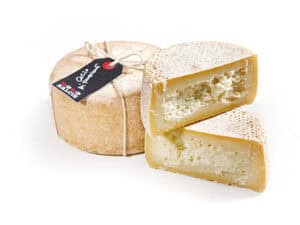 Cacio di Fogliano is raw sheep’s milk 100% from their own herd. This is a semi-soft mild cheese that takes on the notes of the varying herbs the sheep graze on throughout the year.
Cacio di Fogliano is raw sheep’s milk 100% from their own herd. This is a semi-soft mild cheese that takes on the notes of the varying herbs the sheep graze on throughout the year.
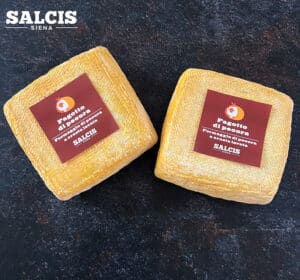 Fagotto–think sheep’s milk Taleggio with a rich deep flavor, smooth paste, creamy texture, and slightly sweet and salty finish from the hand-salting each week. PHOTO of Fagotto
Fagotto–think sheep’s milk Taleggio with a rich deep flavor, smooth paste, creamy texture, and slightly sweet and salty finish from the hand-salting each week. PHOTO of Fagotto
Rogers Collection and SALCIS are currently testing packaging solutions for transatlantic travel to ensure the U.S. consumer gets the true taste and experience of the best expressions of these cheeses. The goal – transport you to a picnic in the Tuscan countryside.
Written by Leska Tomash